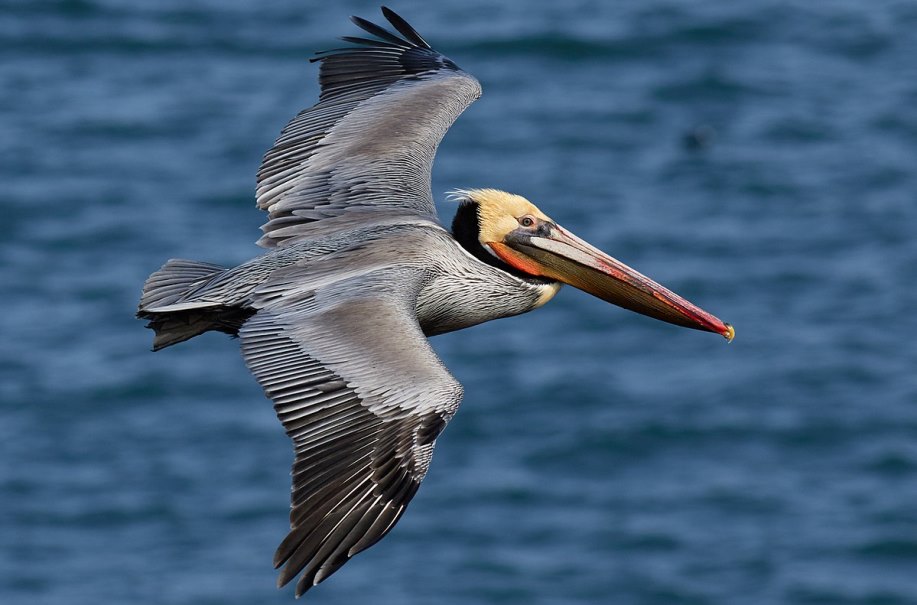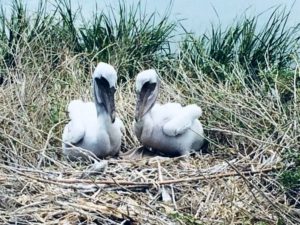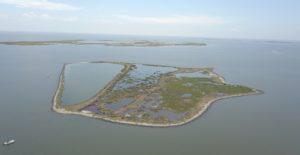Imagine Louisiana without its state bird, the brown pelican. That was reality in the middle 1960s. Pelicans had ceased nesting in the state in 1961, and by 1963, they had disappeared.
The since-banned pesticide DDT was the primary culprit for the demise of the pelican. By 1963, there were no brown pelican sightings anywhere in Louisiana. The federal ban on DDT has helped restore many bird species, especially raptors like bald eagles and ospreys.
(NOTE: The primary purpose of government regulations is to protect the public from irresponsible business behavior. So, when a politician says they are against environmental regulations, that reveals who’s funding their campaign: corporations that want to be free to pollute our air, land or water, if doing so will boost profits.)
Scientists determined that the chemical pesticide prevented the birds, which nest on the ground, from reproducing. In 1968, Louisiana began a project to restock the pelicans, and Queen Bess Island was ground zero. Once a popular nesting spot, the Louisiana Department of Wildlife and Fisheries (LDWF) biologists thought it would be the perfect spot to reintroduce the pelican.
Fifty years later, the agency is celebrating a success story that has brought the brown pelican back from the brink. “To think that we almost lost our state bird, the brown pelican, is inconceivable,” LDWF Secretary Jack Montoucet said.
“As many drive along Louisiana’s coastal region and see the pelican flying above, it is easy to take for granted their great abundance. The job now is to make certain the species continues to flourish. We look forward to working with our partners to ensure that happens,” he continued.
However, in 1968, Louisiana began a restoration project of the species and Queen Bess Island, in Barataria Bay near Grand Isle in Jefferson Parish, was ground zero. Once a popular nesting spot with pelicans, LDWF biologists thought it would be the perfect spot to reintroduce the pelican.
From 1968 through 1976, 767 brown pelican chicks were captured from Florida’s Atlantic Coast and relocated to coastal Louisiana, including to Queen Bess.
In 1971, 11 nests were documented on this tiny island marking the first successful recolonization of brown pelicans in Louisiana. Biologists kept track of the growing numbers and documented a peak of about 4,000 nests on Queen Bess in 2008.
The majestic pelican has returned in a big way with sightings common along Louisiana’s coast. The species was removed from the Federal Endangered Species list in 2009.
Improving the habitat on Queen Bess is a goal of Louisiana’s Coastal Protection and Restoration Authority (CPRA), LDWF and other partners. The island has experienced significant subsidence through the years and the nesting habitat is now approximately five acres and marginal at best.
“In Louisiana we share our living space with more species of the animal kingdom than just about anywhere else in America,” said CPRA Chairman Johnny Bradberry. “If we cannot save the habitat for those species, we cannot save it for ourselves. And as Queen Bess Island proves, every foothold of land is vitally important.”
Queen Bess was heavily impacted by the 2010 BP oil spill. Perhaps one of the most photographed islands during the oil spill, many birds were exposed to oil on this important rookery. It is fitting that the funds to restore the island and to increase nesting habitat for brown pelicans and the other birds that call Queen Bess home is proposed to come from the Natural Resources Damage Assessment (NRDA) funds allocated for birds in Louisiana.
To help reinvigorate the population and add to Queen Bess’ size, CPRA and LDWF are designing a restoration project that may begin as early as 2019. The tiny island is currently the third largest rookery in Louisiana for nesting pelicans with 15-20 percent of the state’s nesting activity occurring on Queen Bess. It is also nesting habitat for about 10 species of nesting birds and commonly has over 4,000 nests annually.
In many ways, the brown pelican is an indicator of the health of the Louisiana coast. The rookeries are on the front line of the coastal land loss crisis and experience all the devastating effects from oil spills to hurricanes as exposed barrier islands of Louisiana’s coastal marshes. As these rookeries subside and erode, pelicans are forced to move inland to find suitable alternatives. However, with meaningful restoration there is hope Louisiana’s state bird can continue to thrive and call the state’s coastal marshes home.
Featured photo of brown pelican by Frank Schulenburg via Wikipedia.



